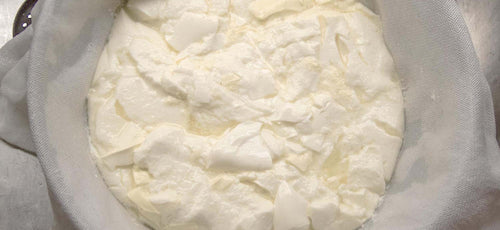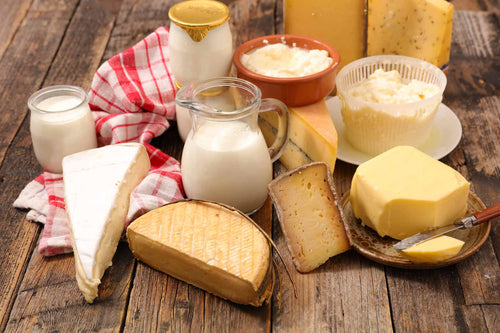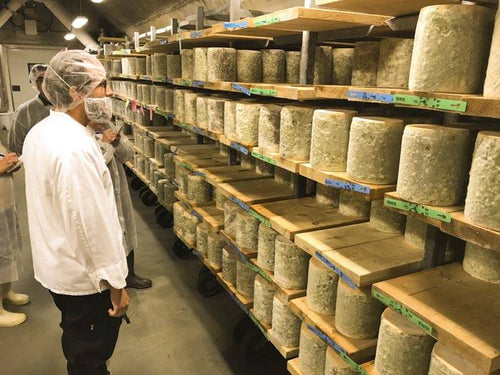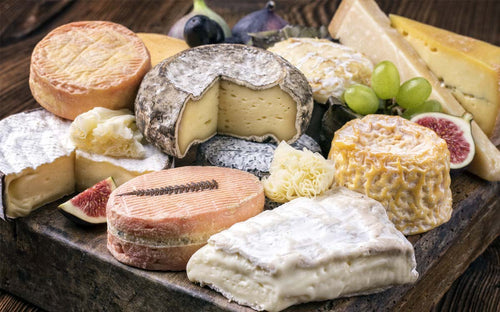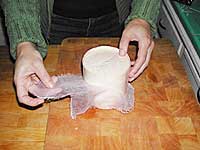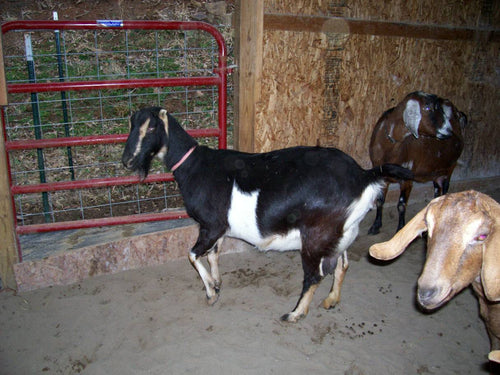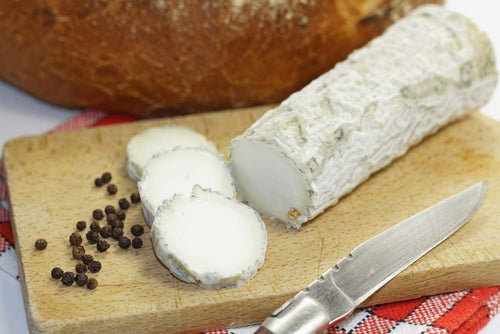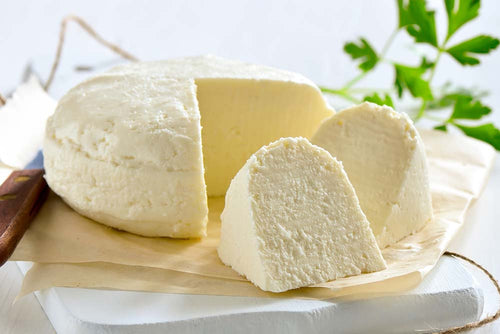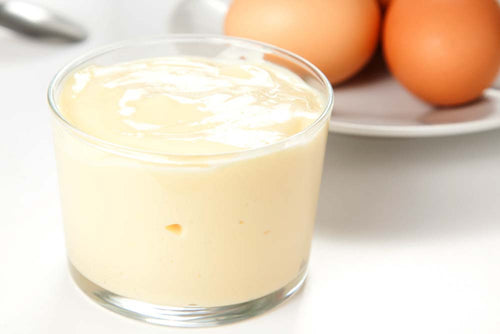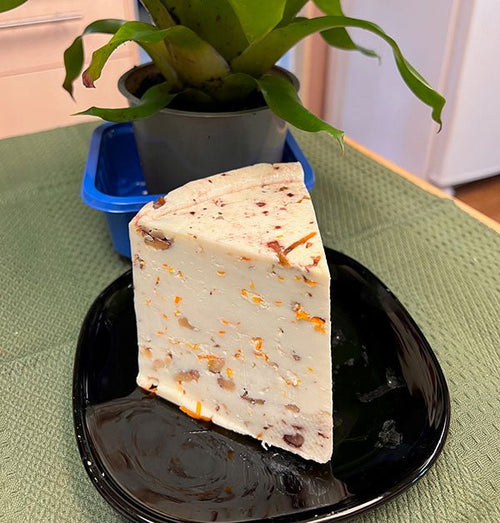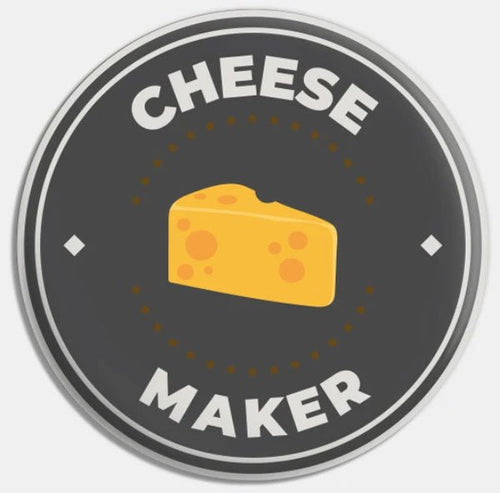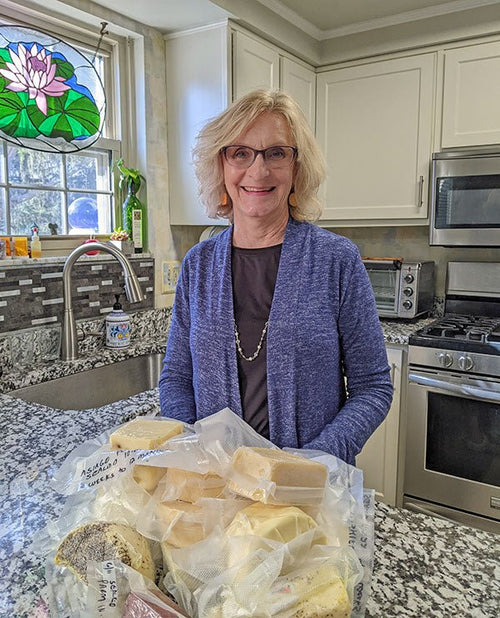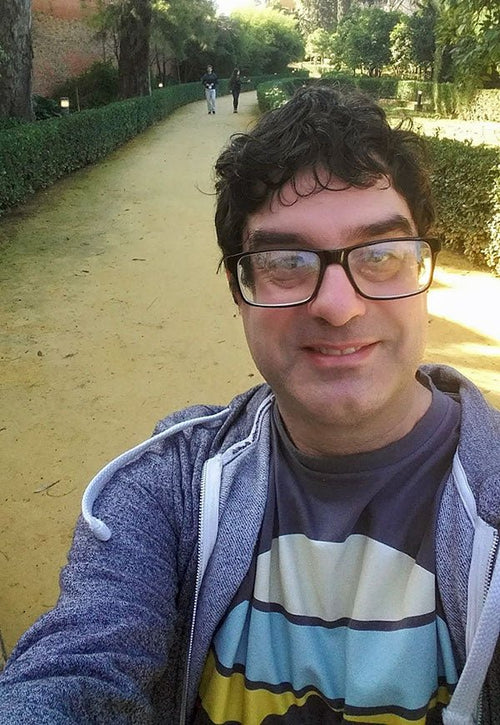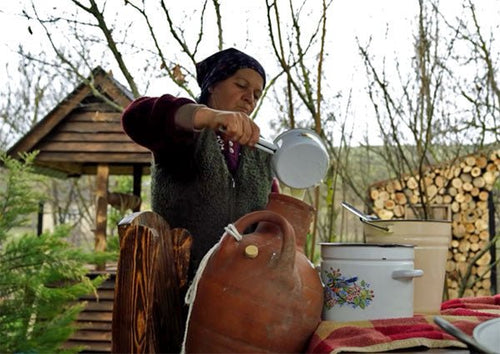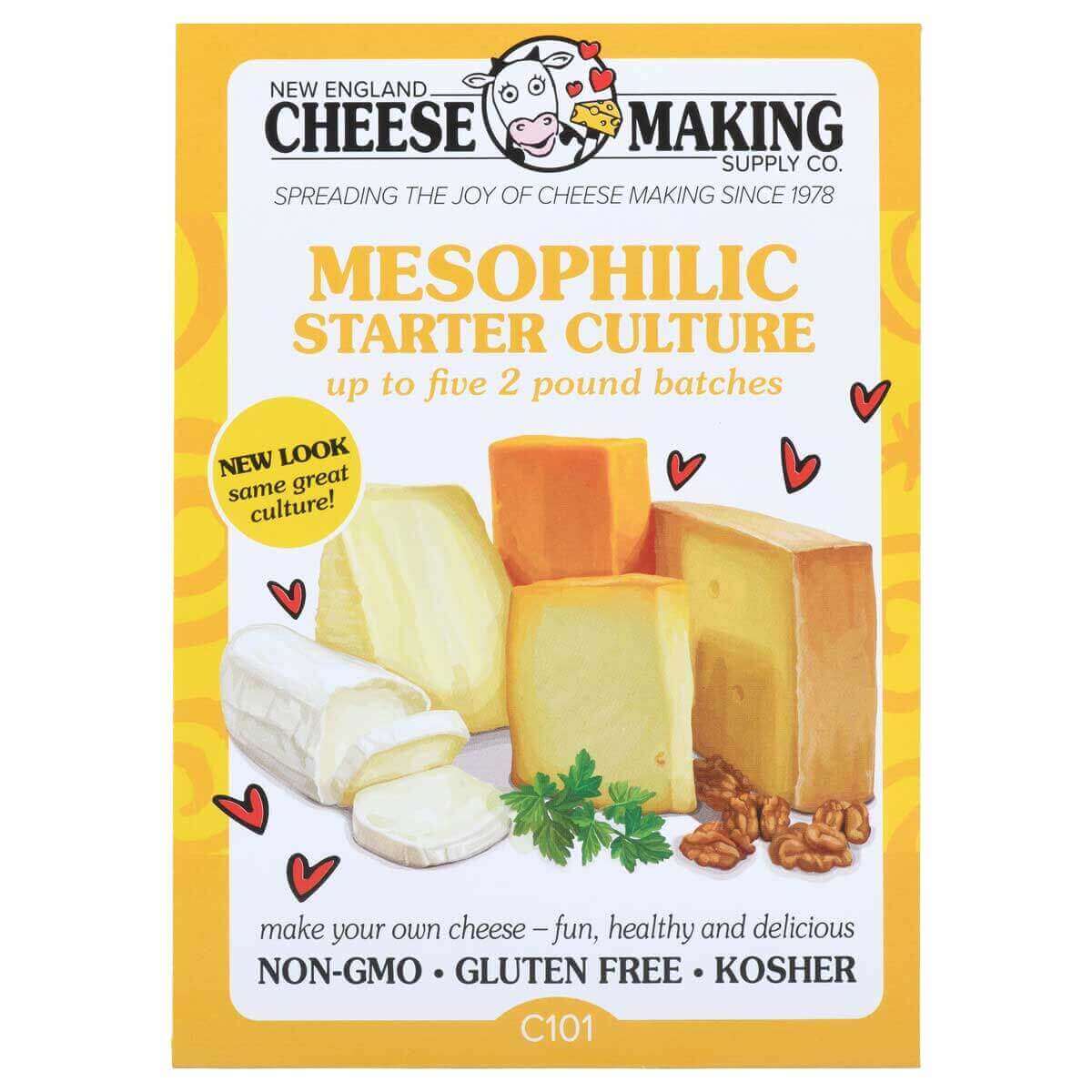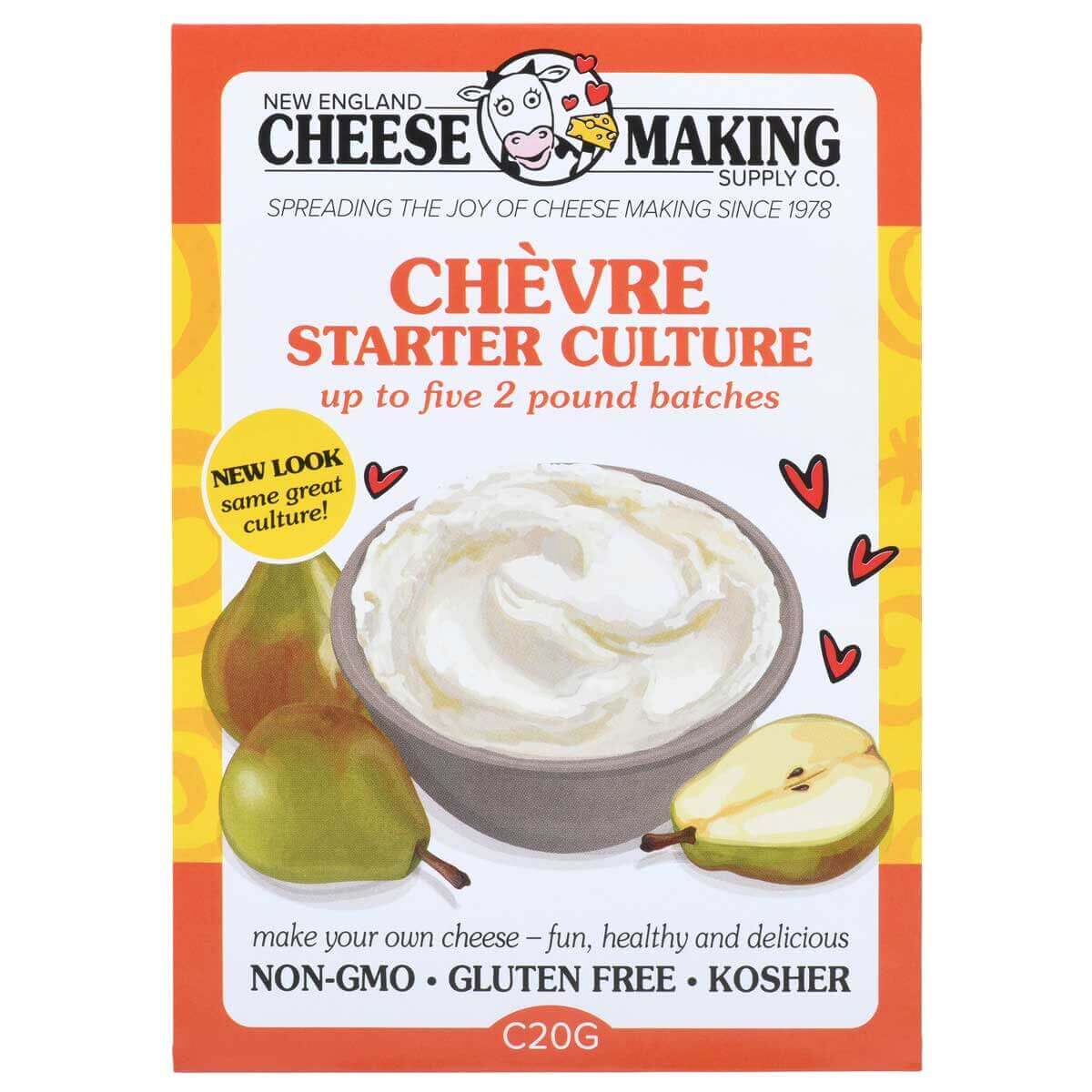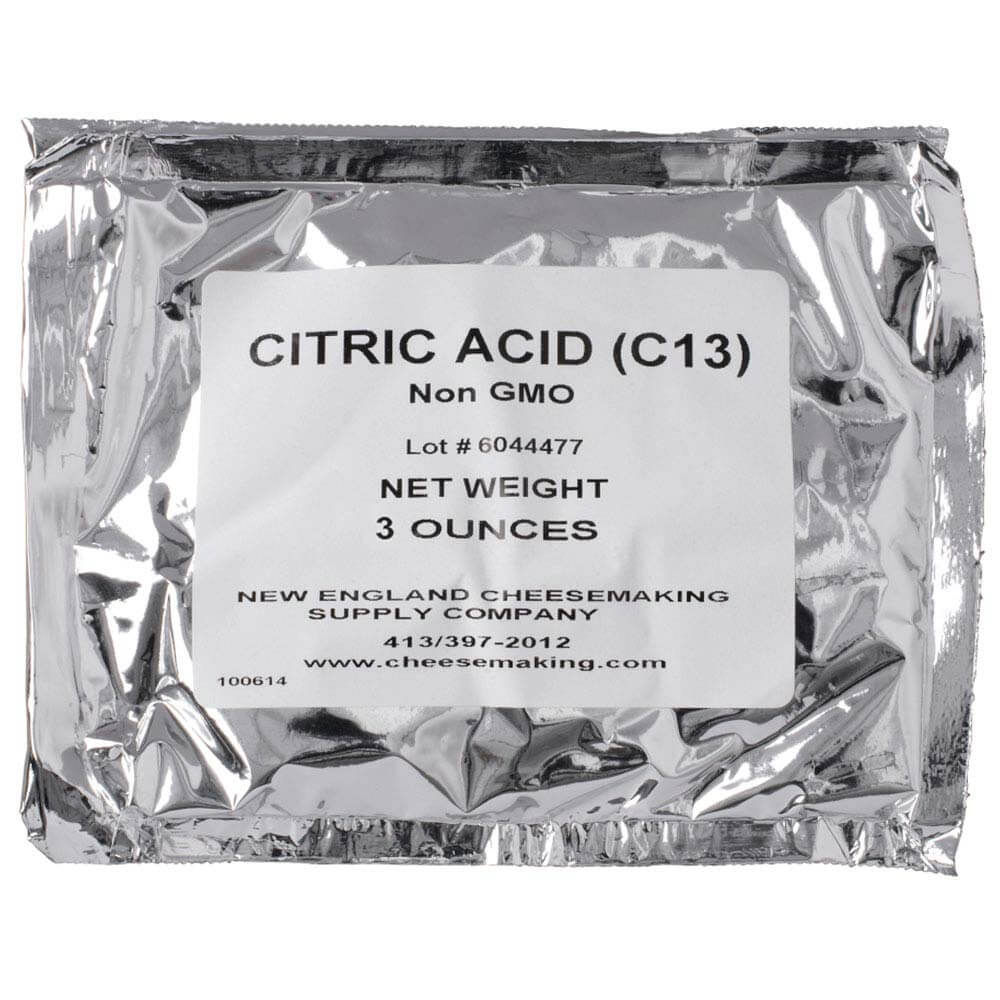Susan Marquis from Arlington VA. has been a cheese lover and home cheese maker for quite some time now. She sent us these wonderful photographs and her story from a recent trip to Italy.
A typical small (but efficient) dairy in Italy, also one efficient guard dog. As in most small farms in Italy it is essential to produce many products as seen here
Susan and her husband visit a Parma dairy, Caseificio Pieve Roffeno. The Skimmed milk in the copper vats ready to make Parma as well as the finished cheese resting in their forms.
The specific Reggiano imprint forms are inserted, cheese salted , and taken to the ripening shelves. After inspectors approve and brand the approved cheese, it is ready for it's long rest and aging.
The whey from the Parma process has been collected, heated with steam and ready to dip. Nothing goes to waste.
Salting is done during the draining process in the same room as the make. They are then taken to the aging room where the final coat and flavor will develop.
An Account of the Wonderful Trip
“I didn't know a dog could actually eat a car,” I said, as my husband and I tried to figure out our next step. A large white Alpha male was leading a frontal assault on our rented Ford Fiesta, and a half dozen of his pals helped out by barking, snarling, and hurling themselves at other parts of the car. We were trapped on a narrow and deeply rutted dirt road as we tried to make our way to “La Cipressaia,” a tiny farmstead pecorino producer in Panzano, Tuscany. “Roll up your window!” my husband shouted as one dog tried to leap into the car. We couldn’t go forward because of the pack of dogs, one of them now chewing on the front bumper. We couldn't easily go backwards because of the narrowness, steepness and sharp turns of the road through the trees. “Maybe you could get out and guide us around the trees,” he then suggested. As the dog slobber splashed onto the windows, we both rejected that idea. And so backwards we moved, down the steep slope, trying to move slowly enough not to run over the dogs and to limit damage from running into trees. We were concerned about the teeth marks on the bumper until that evening when we backed into a tree in the pitch-black parking lot of the agriturismo in which we were staying. As the glass from the back window flew into the passenger compartment, we realized that the scratched bumper would probably not be the rental agencies greatest concern.
This was all in the first two days of our latest visit to Italy. As they produced the famous Parmigiano-Reggiano, Susan was reminded of the similar artistry involved in making ricotta, which is often created from the whey left over from cheese production. The rich and creamy texture of ricotta complements many dishes, showcasing the skill and dedication of Italian cheesemakers. And it was a wonderful trip, as always. The rental agency was terrific about the car and we had a replacement after an unplanned visit to Florence. My husband, son, and I are food and wine tourists. A majestic duomo, breathtaking art, and Etruscan tombs serve more as beautiful interludes between a wonderful lunch and an inspiring dinner. During our March visit we added cheese producers and factories to our usual list of restaurants, markets, and wineries. We also set our sights on the more obscure cheeses in the regions we visited, using as our guide the Slow Food edition of Italian Cheese: A guide to its discovery and appreciation. Italy is, of course, the country of pecorino, Parmigiano Reggiano, Taleggio, Robiola, Gorgonzola, and Mozzarella di Bufala. Although not as well known for cheese as France, Italy has thirty-one DOP (Protected Designation of Origin) zones. Italian Cheese identifies 293 traditional types of cheese in Italy. Like most of Europe, and similar to food and wine throughout Italy, cheese in Italy is strongly regional. Gorgonzola is made in Piedmont and Lombardy. Mozzarella di Bufala Campana DOP is made in the provinces of Caserta and Salerno, part of the provinces of Latina and Frosinone, and some municipalities in the provinces of Naples, Benevento, and Rome. On this trip, my family and I visited Tuscany and Emilia-Romagna and searched out cheeses we could not find in Washington, D.C., particularly fresh cheeses such as Marzolino del Chianti and Casatella as well as long-aged versions of Tuscan pecorino. Not surprisingly, one of our primary objectives was also to discover the true Parmigiano Reggiano in Emilia-Romagna.
Tuscany is known primarily by numerous types of pecorino (pecorino simply means “sheep’s milk cheese”) varying largely by their age and the treatment of the rind. Other typically Tuscan cheeses are the relatively young Accasciato (sheep and cows milk) and Caciotta Toscana (cow and sheep’s milk), both molded cheeses made to be eaten immediately or after only a few weeks of aging. Tuscan pecorino can vary significantly by town. Pienza is home of the some of the most well-known pecorino, but Pecorino Toscano DOP can be made throughout Tuscany and in some parts of Umbria. Most pecorino, including the Toscano DOP, is now made with pasteurized milk, although, according to Italian Cheese, there is a movement among small-scale cheese makers to return to raw milk. Coagulation results from calf’s rennet at (35-38 degrees C). Curds are cut into hazelnut-sized lumps for soft cheese and smaller pieces for aged cheeses. Cheeses are molded with hoops and later brined. Soft pecorino ages for at least 20 days, resulting in a pure white cheese with no significant rind. Aged pecorino stays in the cellar for at least four months but can age much longer. Non-DOP Tuscan pecorino rinds can be rubbed with oil and tomato (common in pecorino from Pienza) or with ash (as in a cheese we purchased in Panzano in Chianti).
We had been to “La Cipressaia” di Tolu Giovanni a few years earlier, before I was making cheese, and we returned this time with the intent of learning more about this farmstead cheese created from the raw milk of the sheep pastured next to the small cheese-making building. We had remembered that the family had a large dog or two, having been startled in our first visit by one that leapt at our son and me when we were walking through the barn admiring some of the sheep. Fortunately, during that first visit, the dog was chained and nearly strangled himself with his leap. We were told not to worry since members of the family were near by.
“La Cipressaia” has long produced artisanal pecorino and ricotta. The family also runs an agriturismo across the street from the cheese factory and sheep, just outside of Panzano. Tolu Giovanni, the matriarch of the family, is a small, strong deeply tanned Sardinian woman whose age is somewhere between 80 and a 100 years old. She is also one of the largest land owners in the area.
During our first visit I spoke to Senora Giovanni in my rudimentary but generally effective Italian. I was surprised that she did not appear to understand anything I said and I struggled to comprehend her explanation of their cheese making process. As I spoke to her niece, I learned that Senora Giovanni speaks Sardinian and has no significant Italian. This was critical to my rather fragile confidence in my Italian language abilities.
When we gathered the courage to make another attempt at visiting La Cipressaia, my husband and I took a more cautious route rather than making a direct assault. We asked our friend and host at agriturismo Fagiolari in Panzano to call ahead. Giulietta arranged for us to meet the Giovanni family at their agriturismo. There we were met by Senora Giovanni, who spoke at some length and eventually made it clear (in Sardinian) that her nephew would meet us at the cheese factory and all would be well.
Driving up the dirt road in our replacement Fiesta, we found the dogs chained up, the sheep watching from behind the barn, and Senora Giovanni’s nephew waiting for us. The nephew was a bit puzzled that American tourists wanted to see the backrooms of his cinderblock building but was more than willing to show us around and explain their cheese-making process in Italian. The facility is in a building adjacent to the sheep barn. It is rudimentary but spotless. There are three work/processing rooms and a storeroom. One room has several large kettles for heating the milk, two stainless steel work tables and a display rack on one wall with a few bottles of La Cipressaia olive oil and honey. There is a separate room for drying cheeses on wooden racks and then an aging room, also with wooden racks and a stainless steel table. La Cipressaia makes a pecorino fresco that is perfect for breakfast (particularly when drizzled with their honey), as well as a “pecorino stagiannato” that is aged for at least ten months. The aged cheeses are kept in a group at one end of the stainless steel table, lightly covered in a piece of cloth. Their natural rinds are covered with dark brown, yellow, and orange molds, and the texture of the cheese is reminiscent of an aged Parmigiano Reggiano. We bought pecorino fresco that we ate while in Tuscany and a year-old pecorino that we brought back to the U.S.
We had three objectives for the second leg of our trip, up north in Emilia-Romagna: to eat and stay at our favorite restaurant in Italy; to visit Gallerie Ferrari in Maranello; and to visit a mountain dairy cheese-making operation. This was our second time to travel to Savigno, south of Bologna, to stay and eat for two nights at Da Amerigo ristorante and locanda. Our host, Alberto Bettini, is gracious, thoughtful, and a wonderful chef. Da Amerigo has existed since 1934 as a family restaurant. In recent years Alberto Bettini has gained recognition as a strong advocate of local, seasonal foods, using the highest quality ingredients to create exceptional and imaginative dishes with the deepest roots in the food traditions of Emilia-Romagna. Alberto provided regional cheese for Slow Food and Italian Cheese and was more than willing to arrange a visit and private tour of the Parmigiano Reggiano factory Cooperative Caseificio Pieve Roffeno, off a small road high in the Apennines mountains in the southernmost area of the Bologna region.
As we walked toward the Caseificio, we were met by a small, young woman in rubber boots, apron and knit hat who graciously provided an extensive tour in Italian. The facility is supported by seven dairy farms and acts as a cooperative to make and sell Parmigiano Reggiano, ricotta, caciotta (a fresh cheese), and mozzarella – all from cows’ milk. Cheese is made twice a day when the milk is brought in by the seven producers. There is one large cheese-producing room that includes six enormous conical, copper vats where the milk is coagulated and the curds formed. The milk for all of the cheeses appears to be heated with steam. For the ricotta, the milk is heated to 200 degrees Fahrenheit. The parmigiano curds are divided for two cheeses, producing 24 cheeses each day. The cheese is drained in plastic molds and then air dried for two days. The dried cheeses are then brined for more than 20 days using salt from Sicily. The 40-kilo wheels are dried and then brought into the aging room. After the cheese has aged for one year it is tested by looking at its color and rind and by tapping the cheese with a small hammer in several spots on the wheel and listening to the sound that is made. If the cheese passes its tests, the cooperative’s mark is burned onto the rind. If a cheese fails, it is marked with horizontal striations and sold as a generic cheese. All of the cooperative’s cheeses are aged for more than two years and improve with time up to seven or eight years. In a large, dim aging room that was easily thirty feet high (my husband said in hushed tones that we had finally found the cathedral of cheese), we saw row after row of cream colored young cheeses, yellow aging cheeses, and golden brown cheeses dating back to 2001. Literally thousands of gorgeous, fragrant cheeses stacked on their shelves high up into the recesses under the ceiling, where surely angels dwelled.
Our visit concluded with photos, good-byes and a visit to the small store to buy 29-month and 36-month Parmigiano Reggiano, as well as some locally produced prosciutto.
We returned to the United States with a pecorino stagiannato that resembled a moldy cannonball, five pounds of Parmigiano Reggiano, and three large hunks of Pienza pecorino aged from six to eighteen months, plus two pounds of pecorino fresco. I was stopped by security in Charles De Gaulle airport after running my bag through the scanner. The image clearly showed several large round objects and several wedges. When I pointed out which one was parmigiano, which one was an aged pecorino, etc., the guard smiled and said, “aah, fromage,” and waved me on my way. The aged parmigiano has a richness and nuttiness that is nearly impossible to find in the United States. It is unbelievable by itself or with a bit of traditional balsamic vinegar (aceto balsalmico) aged for 30-50 years, which we picked up at Pedroni, a small producer outside of Modena. The pecorino fresco was devoured over two weeks by our family and friends. And I still haven't cut into the pecorino from La Cipressaia. I'm waiting for just the right moment. Its a lovely late spring evening here in Virginia, the windows are all open, and I hear, dogs barking. Surely a sign.









































